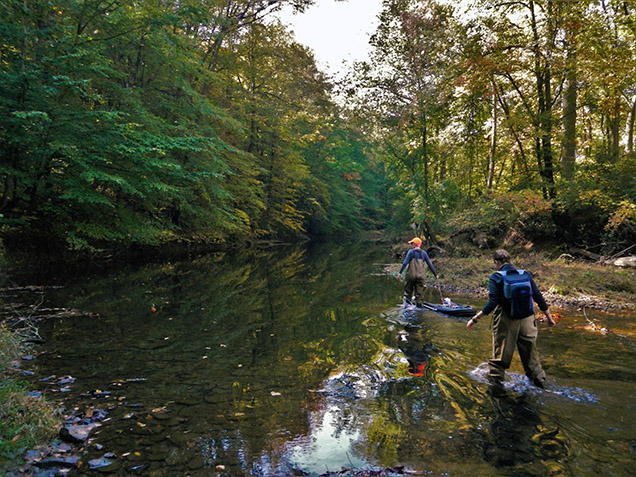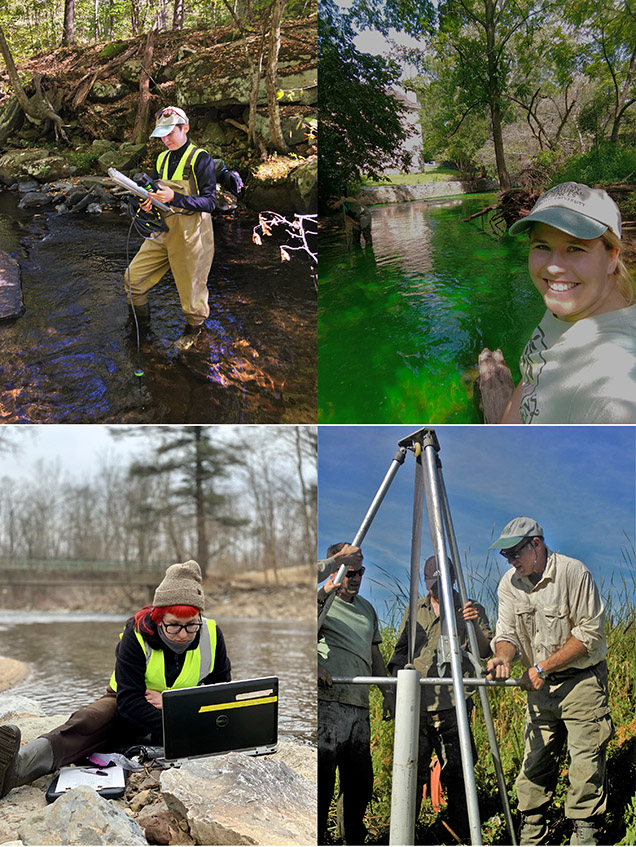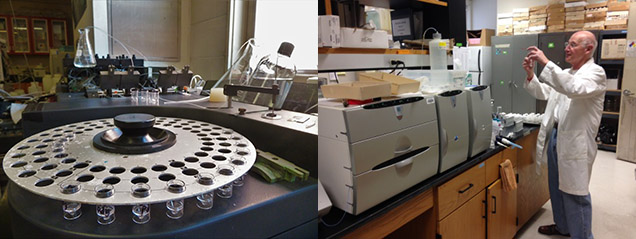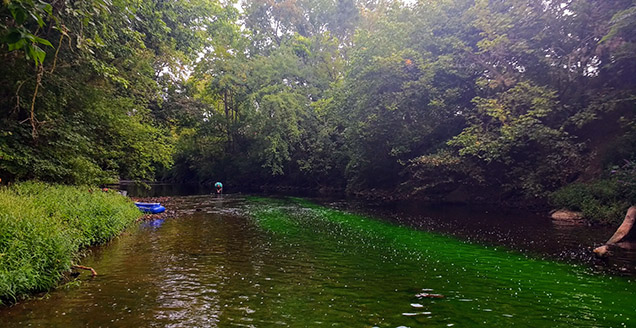Environmental Biogeochemistry

The Environmental Biogeochemistry Section in the Patrick Center is concerned with the influence of organisms on the sources, fate, and transport of chemicals in the aquatic systems. Within the Environmental Biogeochemistry Section many projects deal with the cycling of bioactive elements (carbon, nitrogen, and phosphorus) as well as trace elements (e.g., lead, copper, mercury, and zinc) and organic contaminants such as per- and polyfluoroalkyl substances (PFAS), polychlorinated biphenyls (PCBs) and polycyclic aromatic hydrocarbons (PAHs).
Our projects span the gradient from basic research studies to monitoring programs and environmental assessments. Many of these projects are in partnership with other Sections within the Patrick Center for Environmental Research and the Academy’s collections.
Recent and ongoing projects include evaluating and informing the effect of landscape restoration activities on stream water quality and ecological integrity, nutrient cycling within tidal wetlands, ponds and riparian zones of free flowing rivers, impact of sea-level rise on C and P cycling in tidal freshwater wetlands, contaminant uptake and food-web dynamics, the effects of stormwater runoff to the water, and historical changes in nutrients and contaminants and their impact to the ecology of an estuary.
Click here to learn more about our staff.

Capabilities

- Nutrient cycling in rivers, tidal wetlands and estuaries.
- Non-point sources of anthropogenic chemicals in aquatic systems.
- Fate and transport of major and trace elements and environmental contaminants in aquatic systems.
- Food chain transfers of organic compounds and contaminants.
- Mass balance modeling of trace elements and bioactive elements.
- Whole stream metabolism and related metrics of ecosystem function in stream and river systems.
- Reactive and conservative solute transport in stream systems.
- Stable isotope biogeochemistry of organic carbon, nitrogen, sulfur, oxygen, and hydrogen.
- Stable isotope biogeochemistry of inorganic carbon and oxygen.

Facilities

The Environmental Biogeochemistry Lab at the Academy of Natural Sciences of Drexel University provides a range of analytical services for investigators within the Academy’s Patrick Center and collections and outside investigators. We have a broad range of laboratory equipment to conduct a full range of basic and applied environmental studies. A particular specialty is analyzing low-concentration aquatic nutrient samples.
Instrumentation Includes:
- ThermoFinnigan Delta Plus Stable Isotope Ratio Mass Spectrometer coupled with a Conflo111 and Carlo Erba NA 2500 Elemental Analyzer for bulk organic carbon and nitrogen stable isotope analysis
- Elementar Americas Isoprime100 coupled with a Vario Cube for bulk organic carbon, nitrogen, sulfur, oxygen, and hydrogen stable isotope analysis and a Multiflow for inorganic carbon and oxygen stable isotope analysis
- SmartChem 200 (Discrete Analyzer) and Alpkem (Autoanalyzer) for nutrients, with low detection limits.
- Agilent 8800 Triple Quadrupole ICP-MS for major and trace elements in aqueous and solid samples.
- Dionex ICS-300 Ion Chromatography set up for anion analysis
- Flash 1120 Elemental Analyzer for carbon, nitrogen, and sulfur quantitative analysis
- O I Analytical Aurora 1030 Wet Oxidation TOC Analyzer
- Cold vapor Hg analyzer
- GC-Electron Capture Detector for chlorinated hydrocarbons
- UV-Vis spectrophotometer
- Numerous in-situ water quality meters for pH, dissolved oxygen, salinity/conductivity, and turbidity
- SonTek FlowTracker and River Surveyor for discharge measurements

Selected Projects

- Delaware River Watershed Initiative. Funder: William Penn Foundation.
- Uptake and Bioaccumulation/Biomagnification of Subsurface-Derived PFASs by Lotic, Warm Water Food Webs. PIs: M.J. Kurz, C.M. Sales (Drexel U.), E.R. McKenzie (Temple U.), D.E. Spooner (Lock Haven U.), and C.J. Blakeslee (USGS Northern Appalachian Research Lab). Funder: Strategic Environmental Research and Development Program (SERDP). Project Webpage
- Evaluating Ecosystem Respiration in Urban Streams Using Reactive Tracer and Dissolved Oxygen Loggers. PIs: M.J. Kurz and S. Ledford (Temple University). Funder: National Science Foundation.
- Nutrient and Carbon Fluxes to Barnegat Bay from Marginal Saline Wetlands. PI: D. Velinsky. Funder: NJ DEP, joint with NJ USGS.
- Environmental change: Habitat changes and nitrogen removal in a tidal freshwater marsh. PIs: J. Mead and D. Velinsky. Funder: PA Sea Grant.
- Nutrient and Ecological Histories in Barnegat Bay, NJ. PIs: D. Velinsky, D. Charles and Chris Sommerfield (UDel.). Funder: NJ DEP.
- Sabine River Monitoring. Funder: Eastman Chemical Company.
- Bioaccumulation of Organic Contaminants in the Delaware River Estuary: Role of Tidal Freshwater Marshes. PIs: D.Velinsky and J. Ashley (Philadelphia University). Funder: NOAA Sea Grant.
- Impact of Sea Level Rise on the Cycling of Carbon and Phosphorus in Tidal Freshwater Marshes. PIs: Dr. Melanie Vile (Villanova Univ.), David Velinsky, and Scott Neubaur (Univ. South Carolina). Funder: US EPA STAR Program.
- Distribution of Sediment Contaminant History in the tidal freshwater Potomac River; Washington, DC. PIs: D. Velinsky, G. Riedel (SERC) and J. Ashley. Funder: District of Columbia.
- Historical Changes in Sedimentation and Chemical Loading in Tidal Marshes of the Delaware Estuary. PIs: Chris Sommerfield (UDEL) and D. Velinsky. Funder: Delaware River Basin Commission.